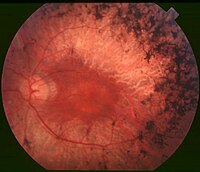
Photo from wikipedia
Abstract Variations in the human Crumbs homolog‐1 (CRB1) gene lead to an array of retinal dystrophies including early onset of retinitis pigmentosa (RP) and Leber congenital amaurosis (LCA) in children.… Click to show full abstract
Abstract Variations in the human Crumbs homolog‐1 (CRB1) gene lead to an array of retinal dystrophies including early onset of retinitis pigmentosa (RP) and Leber congenital amaurosis (LCA) in children. To investigate the physiological roles of CRB1 and CRB2 in retinal Müller glial cells (MGCs), we analysed mouse retinas lacking both proteins in MGC. The peripheral retina showed a faster progression of dystrophy than the central retina. The central retina showed retinal folds, disruptions at the outer limiting membrane, protrusion of photoreceptor nuclei into the inner and outer segment layers and ingression of photoreceptor nuclei into the photoreceptor synaptic layer. The peripheral retina showed a complete loss of the photoreceptor synapse layer, intermingling of photoreceptor nuclei within the inner nuclear layer and ectopic photoreceptor cells in the ganglion cell layer. Electroretinography showed severe attenuation of the scotopic a‐wave at 1 month of age with responses below detection levels at 3 months of age. The double knockout mouse retinas mimicked a phenotype equivalent to a clinical LCA phenotype due to loss of CRB1. Localization of CRB1 and CRB2 in non‐human primate (NHP) retinas was analyzed at the ultrastructural level. We found that NHP CRB1 and CRB2 proteins localized to the subapical region adjacent to adherens junctions at the outer limiting membrane in MGC and photoreceptors. Our data suggest that loss of CRB2 in MGC aggravates the CRB1‐associated RP‐like phenotype towards an LCA‐like phenotype.
Journal Title: Human Molecular Genetics
Year Published: 2019
Link to full text (if available)
Share on Social Media: Sign Up to like & get
recommendations!